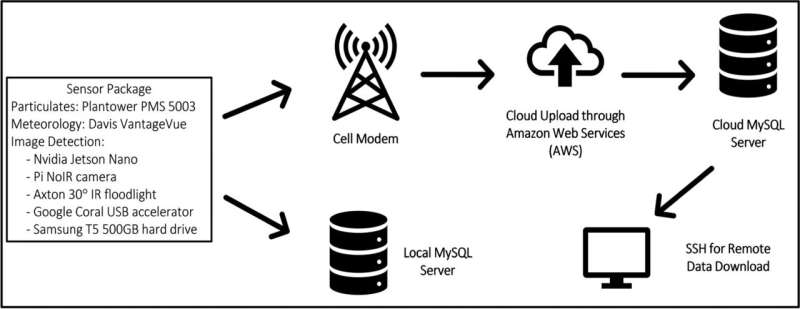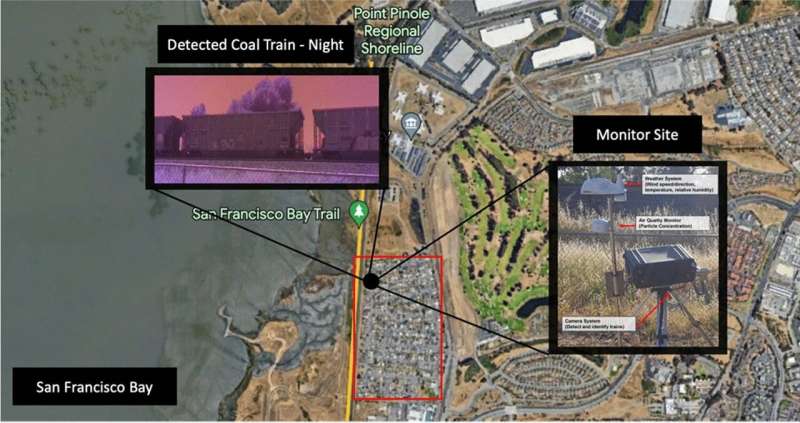This article has been reviewed according to Science X's editorial process and policies. Editors have highlighted the following attributes while ensuring the content's credibility:
fact-checked
trusted source
proofread
Coal trains increase air pollution in San Francisco bay area

Coal trains and terminal operations add a significant amount of fine particulate matter (PM2.5) pollution to urban areas, more so than other freight or passenger trains, according to a study conducted in Richmond, California, by the University of California, Davis.
The paper, published in the journal Air Quality, Atmosphere & Health, is the first study of coal train particulate pollution in a U.S. urban area. It's also the first to use artificial intelligence technologies to verify that the source of air pollution detected comes from coal.
It found that passing trains carrying coal add on average 8 micrograms per cubic meter of air (ug/m3) to ambient PM2.5 pollution. That is 2 to 3 ug/m3 more than freight trains contribute. Even empty coal cars add about 2 ug/m3 to the air due to traces of coal dust. Under certain wind conditions, these concentrations reached 25 ug/m3.
Environmental justice concerns
The authors released a full report this week to the California Air Resources Board with additional measurements of coal and petroleum coke (a byproduct of oil refining). It demonstrated that the storage and handling of these materials at shipping terminals and train holding yards also emit PM2.5, and that this air pollution reaches residential communities.
That report further describes the health and environmental justice implications of coal-related pollution for residents in Richmond and in nearby Oakland, where a coal terminal proposal is currently under discussion.
"Across the world, trains tend to go through the lowest-income and most vulnerable parts of communities," said lead author Bart Ostro, a scientist with the UC Davis Air Quality Research Center. "Rail conveyance of coal represents a significant local and global public health hazard and environmental justice concern. That's why quantifying the contribution of coal trains in urban areas is so important."
Artificial-intelligence uncovers pollution
Rail conveyance of coal accounts for one-third of U.S. rail freight tonnage and is a source of fine particulate matter, which is associated with a range of health problems, from heart and respiratory disease to premature death and adverse birth outcomes. But the contribution of air pollution from coal trains has been difficult to quantify, given difficulties in monitoring and discerning coal-carrying trains from other trains.

For this study, UC Davis air quality researcher Nicholas Spada developed an artificial intelligence-driven monitoring system to quantify the average and maximum PM2.5 concentrations of full and empty coal trains compared to freight and passenger trains. The device can differentiate between coal, freight and passenger trains, day or night, and measure the fine particulate pollution they produce in real time.
Between May 2022 and October 2022, the monitor was placed along train tracks in Richmond, a city in the San Francisco Bay Area with a racially diverse population of about 115,000 people and high rates of asthma and heart disease. Other monitoring took place over the past two years.
The authors found that coal transport, storage and handling significantly increase community exposure to ambient PM2.5.
"The sheer scope of the project inspired us to experiment with computer-learning," Spada said. "We developed a cutting-edge system, and it really paid off. Several thousand trains were observed in this study and were classified with a high degree of confidence. This included passenger, freight, and unloaded and full coal cars."
The researchers said an unforeseen benefit was that this technology can be applied to help pinpoint the source and level of pollution of many air pollution concerns, from refinery flaring and construction dust to unloading and loading at shipyards.
No safe level
The World Health Organization and U.S. Environmental Protection Agency indicate there is no known safe level of PM2.5. A recent study of the Global Burden of Disease estimates that fine particulate matter pollution contributes to 6.7 million deaths per year globally.
"Adverse effects are borne disproportionately by the most vulnerable, including infants, children and the elderly, people of color, those with low incomes and those with underlying health conditions," the authors wrote.
The scientists did not measure ultrafine or coarse particles (PM10), which are also generated with PM2.5. This indicates that the study likely underestimates the actual health risks posed by passing coal trains.
More information: Bart Ostro et al, The impact of coal trains on PM2.5 in the San Francisco Bay area, Air Quality, Atmosphere & Health (2023). DOI: 10.1007/s11869-023-01333-0
Provided by UC Davis


















